- Getting around Lijiang. Dont stay in the Old Towns more than 2 days, there is nothing to do. KRISS Oct 9, 2013 05:46
- 2013 Beijing Temple Fair BENNYLAU Feb 26, 2013 03:29
- Malaysian traveling from KUL - LAX vis Shanghai PVG ZATI_DY Jan 3, 2013 20:15
3 Days in Zhejiang: Hengdian Film Studios
- Views: 10753
- |Vote: 3 0
- |Add to Favorites
- |Recommend to Friends
Day 3: Rickshaws and Rip-offs
It was the final day of our three-day May holiday trip in Zhejiang Province (浙江省) and we were heading out on a pre-8am public bus from Dongyang (东阳) to the “village” of Hengdian (横店). A 20-minute ride or so later and we were dropped off at the centre of a small but bustling crossroads and a crowd of rickshaw drivers descended upon us.
Having taken a breath, I left my companions to joust with the rickshaw drivers and their laminated itineraries whilst I ran around to a few shops to try and procure a map. By coincidence, or by design, there were no maps to be found in any of the shops that I tried and I returned to my colleagues empty handed.
Thankfully we knew where we wanted to go and eventually two of the rickshaws agreed to take us there for 20RMB per rickshaw.
Once the journey was underway, the female driver of my rickshaw began trying to increase the price, advising me that it was a long way and a lot of work. I reminded her that we had told her where we wanted to go and she had already given us a price. Undeterred by this original agreement, she (and her fellow driver carrying my companions alongside) spent the entire journey trying to get us to pay more. I could only understand a little of her dialect, but I was increasingly irritated by her insistence that we were foreigners and had a lot of money so why should we mind paying double the original price!
10 minutes later, our destination in sight, the rickshaw drivers stopped and refused to take us any further. I had told them that there was no way we would pay extra and so they decided they would drop us a few hundred metres from the place where we were going. I only wish I had managed to convince them that it was not the fact that we are miserly foreigners but that they broken their side of the bargain – alas, they left certain that they had been wronged.
Day 3: Hengdian – A Success Story
Just 13 years ago, Hengdian Village was as typical a Chinese village as you could hope to find. One man, Xu Wenrong, changed all that forever in 1995 when he helped the director Xie Jin to build a set for his grand movie “The Opium War”. When the movie was released, Hengdian became famous overnight and it wasn’t long before other directors, interested in Xu’s speed and skill at creating authentic sets, came to seek him out.
With the help of locals, Xu was able to design replica palaces from the Qin, Qing and Ming Dynasties that have been used by such illustrious Chinese directors as Chen Kaige for his movie “The Promise” and Zhang Yimou for “Hero”. Since then Hengdian World Studios (as it became known) has gone from strength to strength boasting 13 film sets and seeing over 6,000 episodes of TV dramas being filmed there as well as countless movies. The once backwater village now thrives on the twin blessings of both the film industry and tourism – receiving millions of visitors every year.
It is hardly surprising then that Hengdian glows with the surreal spirit of movie-making: here is a place where it is possible to wander through the streets of 19th Century Hong Kong or Guangzhou; visit a South Liang Dynasty (AD502-557) temple boasting the largest indoor figure of Sakyamuni in China; or stroll through the streets of an ancient riverside town: and this is just the start of it. The film sets cover an area of 330 hectares and are the largest in Asia.
Xu Wenrong’s ambitions seem to know no bounds and it is one of his grandest sets, a replica of the Forbidden City, that we especially wanted to see.
[Golden Flowers & May Holiday Crowds: Zhang Yimou's "Curse of the Golden Flowers" was also filmed here]
Day 3: The Forbidden City, Hengdian
So it was that the rickshaw drivers had dropped us a short walk from the Forbidden City but thousands of kilometres from Beijing. I couldn’t have imagined that, in the middle of Zhejiang Province, there lay a full scale replica of one of the most famous and enduring symbols of Chinese history. Yet, that was what appeared before me.
Having previously visited the “real” Forbidden City in Beijing, I was not expecting anything to rival it, but I was mistaken. Of course, there was not the backdrop of Beijing, the extraordinary wide avenues, Tian’anmen Square or for that matter the murky skies and sounds of traffic. Instead, here, densely forested mountains stood in the distance against a blue sky hazy with heat. Of course, there were no armed soldiers standing guard at the entrance and no portrait of Chairman Mao watching from the walls. Instead, there were the same colours, textures and shapes – the essence of the Forbidden City – that seen in a movie would be all but indistinguishable from the original.
The layout of the original is faithfully reproduced and on more detailed inspection, I was amazed at just how precise this replica was. The same great bronze urns, the same carvings on the rooftops, the same ornamental dragons’ heads breathing from the white stone balustrades. In fact, Hengdian’s Forbidden City would pass more than just a cursory glance, and it’s an impressive feat accomplished in just 14 months (the original took 14 years.)
Most impressive was the scale, the recreation of the vacuous courtyards between the palaces, the great white spaces contained between the ever-so-distant mud-red walls. Equally, the labyrinthine maze of corridors and small palaces that proliferate towards the rear of the city are fully realised here. So are the gardens, the trees (if not so old as their gnarled-barked counterparts in Beijing) and the terraces of rock. Even more convenient are the outlying hutong that Xu incorporated into this version, making the transition from the Forbidden City to the ancient narrow streets of Beijing just a few steps apart.
[The Forbidden City, a film set, Hengdian Film Studios]
Day 3: Cable Cars
Following the Forbidden City to its rear exit we were instantly reminded that we were not in Beijing. A few hopeful rickshaw drivers stood around gossiping and catching stray tourists who weren’t being herded back onto their coaches, but apart from this there was nothing but farmers fields and the pine infested mountains. Well, nothing except a steady path of blue cable cars that made their way up into the murky greenery and beyond to where a tempting view of temples and pathways fixed on the edge of rocky outcrops greeted the eyes. In silent agreement, we crossed the road to the cable car station to begin our ascent.
The blue cars swung around the turning semi-circle in the station and we bundled clumsily in. Footsore from treading the vast stage of the Forbidden City, I was grateful for the seat although the carriage itself was uncomfortably hot as the late Spring temperatures soared. It was possible to look back and see the myriad, incongruous film sets and dotted between them the much smaller, genuine villages around Hengdian.
The carriage trundled gradually upwards and towards the rocky cliffs that signalled the top of the mountains. Looking forwards I could see that a covered walkway hugged the edge of the rocks and a temple stood boldly on a lone outcrop. I sat and sweated the 15-minute ride and exited with some relief at the top into the fresh, though still humid, air.
[Cable Car View, looking down on Hengdian]
Day 3: Pingyan Caves and Grottoes
In fact, up in the mountains, there was a murmur of a breeze that tempered the heat a little and the pines and magnolias formed natural umbrellas of shade. There were more steep steps to be negotiated before my companions and I found ourselves on a pathway that would take us in a wide circle around the top of the mountain. Famed for its strange stone, quiet caves, abrupt cliffs and red leaves (presumably in autumn) this rocky mountain-top provides yet another jewel for Hengdian’s filmic crown.
A number of small to medium-sized Taoist temples lay scattered over the area, dedicated to various deities, the largest being the one visible from the foot of the mountain honouring the Jade Emperor himself.
To reach this temple it was necessary to walk along the cliff edge. On one side we were afforded sweeping views of Hengdian, the village and the studios set amidst the farmer’s fields. On the other side, in the concave indents of the rock, were placed many bright Taoist figures, including some of the Eight Immortals: notably He Xiangu (何仙姑), the only female immortal, with her lotus flower representing health and Li Tieguai (李铁拐, sometimes called Iron-Crutch Li), a dirty, ugly man, oldest of the immortals, carrying medicine in his gourd and leaning on his iron walking stick.
Further around the cliff-edge path and there is a small chasm. A short wooden-plank walkway bridged the gap and an old woman was sat at the opening of the chasm with a basket filled with small stones. Inside the chasm a large bell has been suspended and for 5RMB the woman will give you a stone to throw at the bell. If you hit the bell – and it did not appear to be too difficult to do that, as the old woman demonstrated to us – you would receive good luck.
[Taoist Temple]
Day 3: An Unexpected Lunch & Home
After over half a day of wandering, we were all surprised to come across a restaurant at the far end of the mountain-top path. Taking advantage of a huge, natural cave in the cliff face, the open-air restaurant was situated spectacularly under a vast, craggy overhang. Set into the back of the cave were a row of statues that were in fact all the Emperors of China, ending at last with the small child Emperor, Puyi (溥仪), sat on a stool.
Several large tables were set out and we couldn’t resist having lunch there along with many other May holiday diners: a delicious chicken stew, potatoes, tofu and a few bottles of beer, not unreasonably priced, came to about 100RMB. The location alone was well worth the money.
We returned to the cable cars via the top path of the circular route that passed between overgrown shrubs and trees and opened out by the edge of a concrete pool. It looked like an outdoor swimming pool but despite evident neglect, the waters stirred and a turtle popped its head out of the grimy waters to take a breath before disappearing.
The descent was hot and sticky, each cable car resembled a tiny private sauna. At the bottom a man with a motorised rickshaw gave us a bumpy ride back to the bus station for 10RMB each. Traffic regulations meant he couldn’t drive into the station itself so he took us the back way, dropped us off nearby and showed us a short-cut. We thanked him, his help more than made up for our earlier run in with rickshaws and made for a happy ending as we negotiated the holiday crowds, bought our return tickets and sank into our seats heading home to Hangzhou.
[Cable Cars/Saunas and landscape]
Information (May 2007)
Hengdian Film Studios are located in the village of Hengdian (横店), Zhejiang Province (浙江省). The nearest town is Dongyang (东阳).
Getting There
From: Dongyang (东阳)
By: public bus
Price: 5RMB
Time: 20 mins+
Getting Away
To: Yiwu (义乌)
By: bus
Price: 6RMB
Time: 30-40mins
From: Yiwu (义乌)
To: Hangzhou (杭州)
By: air-conditioned coach
Price: 53RMB
Time: 2 hours (approx)
Hengdian Film Studios
The Forbidden City
60RMB per person
Pingyan Caves (including return cable car ride)
50RMB per person
Tickets are available for all the film sites/sets individually ranging from 50RMB to 60RMB per site. Combined tickets are also available giving a small discount on individual site entrance prices.
[Hengdian Film Studio sets]



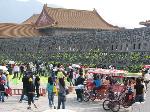
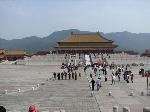

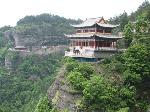
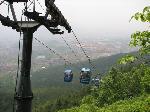
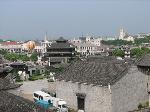
 Copyright © 1998-2025 All rights reserved.
Copyright © 1998-2025 All rights reserved.